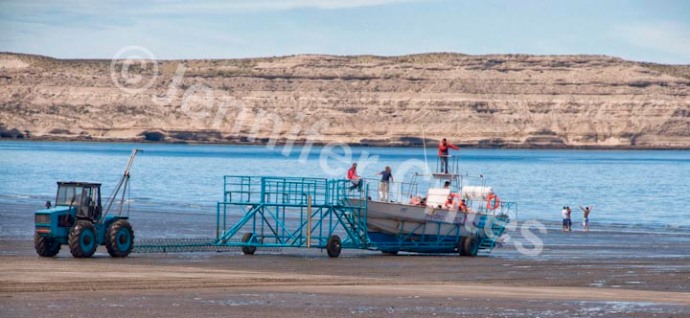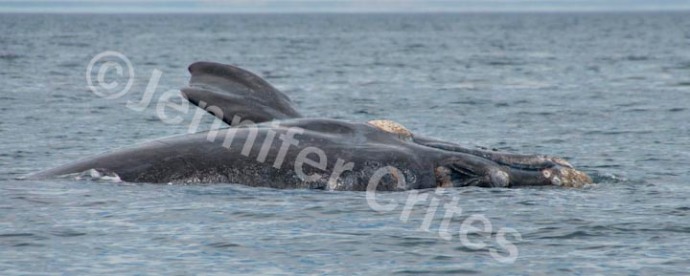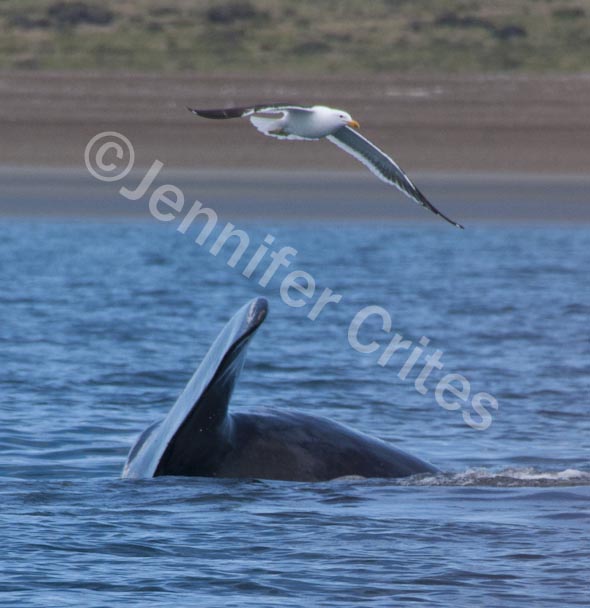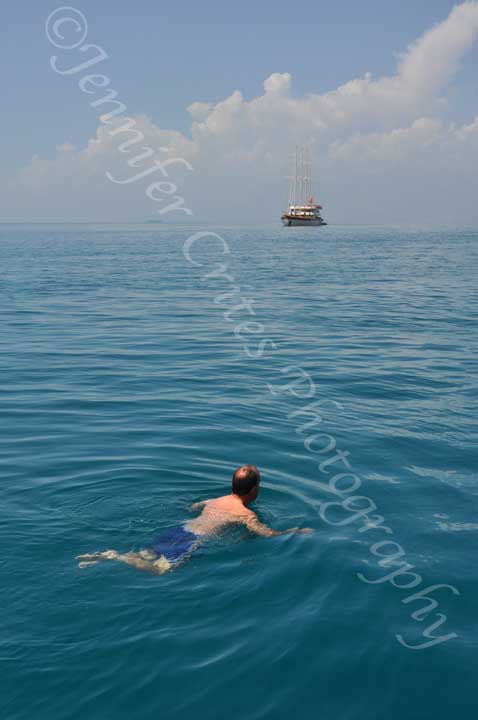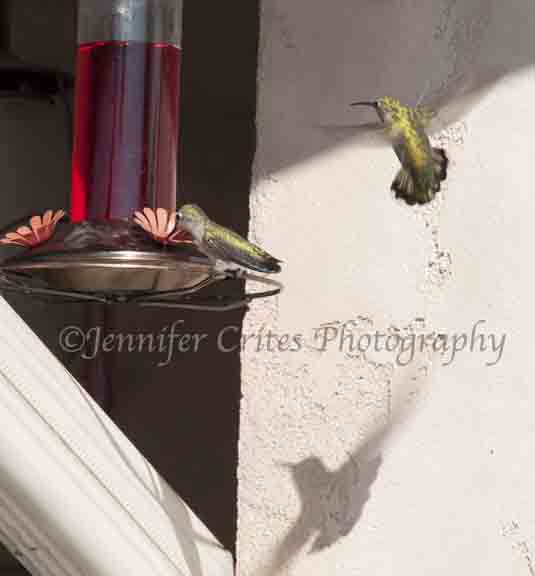On this two-day trip out of Hanoi, we passed trucks loaded with pigs, and dozens of duck farms, all supplying restaurants in Hanoi. At the Cuc Phuong National Park’s conservation center, we were hoping to spot a pangolin (a rare, scaled animal that, in photos, reminded me of an armadillo), but they were only on view at certain times of day, so we missed them. We did visit the monkey and turtle sections though. After a night in our Ninh Binh hotel, we visited a temple and then boarded a small, flat-bottomed boat for another river trip where all the rowers used their legs and feet at the oars. Dozens of tourist-filled boats joined us as we made our way down the river, past even more spectacular scenery, and through three low-hanging caves. I was sure we would have to duck or bump our heads, but the rowers knew the safest channel to take. Outside the caves we encountered a floating market of sorts. Several sellers in boats tried to entice us to buy their wares, imploring us to at least buy food for our rower.
environment
Exploring North Vietnam: Ninh Binh—Three Caves, a River, and an Animal Sanctuary
Exploring Vietnam: Yen River & Pagoda
On a day trip from Hanoi, we headed southwest, ostensibly to visit the Perfume Pagoda in a Huong Son mountain cave. The only way to get there, following a 2-hour drive, is a boat ride along the Yen River, then a cable car up to the cave—a pilgrimage site to which thousands go during the religious Tet festival in March and April.
The drive out of Hanoi showcased Vietnam’s watery countryside. When we arrived at the river, the tiny boat was big enough for us, our guide, and the boat’s rower, and the one-hour trip upriver proved serene and scenic. We passed watery fields of pink lotus blossoms (which apparently start closing at noon), travelers in other boats, a red foot bridge high above the river, and kingfisher birds clinging to branches, before arriving at the elaborate Thien Tru Pagoda temple complex. Fortunately, we were there in November, and the place was almost deserted—a situation that was perfect for exploring and photography but posed some problems: The Ladies restroom was locked, so I had to use the Men’s, while our guide stood guard outside. Also, we were told that the cable car was not running (not enough people, I suppose), so we couldn’t go up to the Perfume Pagoda. After a bountiful lunch, we explored the extensive temple complex, then rejoined our boat and rower for the trip back down the river. By this time, all the lotus blossoms had closed, but the scenery was still spectacular.
Please enjoy! Just click on a photo to enlarge, then arrow back and forth.

How Hawaiian Cotton Helped save the U.S. Cotton Industry

Circa 1892, a small beetle native to Central or South America made its way across the Mexican border in the vicinity of Brownsville, Texas and spread rapidly across cotton-growing regions. By the 1920s, Anthonomus grandis, the boll weevil, was causing more economic damage than any agricultural pest in U.S. history.
The boll weevil feeds on cotton pollen, but does its damage by laying eggs on cotton flower buds called “squares,” or on the young developing cotton boll, which provides the beetle with a platform for its “home.” The infected bud or boll stops developing and often falls off as the beetle larvae eat it. The destruction spread from Texas across the South and Southwest, so that by the Great Depression, cotton farmers had already suffered from many years of devastatingly poor harvests. Eventually, it found its way to California cotton fields as well.
The first pesticide used on infested cotton crops was arsenic, but the boll weevil developed a tolerance for it. Another pesticide, DDT, was tried in the mid-twentieth century, but, once again, the pests developed a resistance to it. Plus, the heavy application of pesticides killed a wide spectrum of beneficial insects, allowing other pests to increase their numbers and damage cotton and other crops. And there was a danger of polluted adjacent food crops, water supplies and consequential ecological damage.
But humans are adaptable, too. A variety of strategies—started in the 1970s—such as pheromone traps in the spring, hand picking infected cotton buds during the growing season, plowing under the cotton stalks after harvest, and low levels of pesticides when the insect is short of food in the fall, all helped to stem the destructive tide of boll weevil devastation.
An important ingredient in the mix was Hawaiian cotton. When ma’o is crossed with other cotton strains, the resulting commercial hybrids are less attractive to insect pests that destroy cotton crops. Ma’o lacks the flavor lactones within the nectar which would otherwise attract insects to commercial cotton.
Now, in most states, the boll weevil and other cotton pests have left and are unlikely to return. But in Enterprise, Alabama, the city has erected a statue to the boll weevil because, they say, there is a great deal we can learn from an invasive bug, even as we show it the door.
Perhaps they should erect a statue to Ma’o, the Hawaiian cotton plant, too.
p.s. visitors to Oahu, Hawaii, can find ma’o growing wild along the dry slopes at the Makapu’u scenic lookout.
George Patton once dropped bombs on our Hawaii volcano to stop a lava flow
Golden Sunrise

Beautiful nature to brighten up the day
Photo of the Day: Iguazu Falls—a Natural Wonder
 I’ll never forget the jolt of amazement when I rounded a bend on the elevated walkway and saw this view. To capture the breadth and the feeling of power emanating from such close proximity to the rushing water and billowing spray, I took four images, from side to side, and later stitched them together in Photoshop, creating this stunning panorama, which includes the Iguazu River and San Martin island.
I’ll never forget the jolt of amazement when I rounded a bend on the elevated walkway and saw this view. To capture the breadth and the feeling of power emanating from such close proximity to the rushing water and billowing spray, I took four images, from side to side, and later stitched them together in Photoshop, creating this stunning panorama, which includes the Iguazu River and San Martin island.
Spying on Southern Right Whales
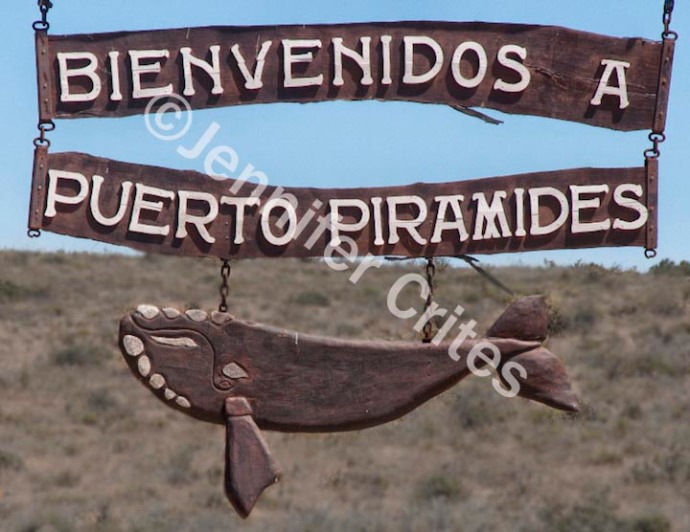 It’s early afternoon in Argentina’s Patagonia, and on Peninsula Valdes, the seaside town of Puerto Piramides is throbbing with tourists lining up to pay for their whale-watching tours. The little hamlet has grown up around these tours, with lodging, restaurants, souvenir shops and a tourist information bureau all catering to the trade and brimming with business.
It’s early afternoon in Argentina’s Patagonia, and on Peninsula Valdes, the seaside town of Puerto Piramides is throbbing with tourists lining up to pay for their whale-watching tours. The little hamlet has grown up around these tours, with lodging, restaurants, souvenir shops and a tourist information bureau all catering to the trade and brimming with business.
Beyond the last restaurant, on an ultra-wide beach fronting a horseshoe bay, there are no boat ramps. Instead, tractors—like monstrous crabs—chug across the sand, pushing and pulling tour boats into and out of the ocean with the aid of long metal arms. Ignoring the vehicles, groups of sunbathers and daytrippers dot the sandy expanse. There’s plenty of room for everyone.
From the ticket office, we march in line to the beach after donning our bulky orange life jackets. Across the sand we go, up the metal steps to the boat’s deck in search of a good seat. During a lengthy orientation in both Spanish and English (mostly Spanish), a tractor pushes us into the sea, and at the proper depth, we float off the trailer and are on our way to see the whales.
It’s speculated that right whales, both Northern (Pacific and Atlantic) and Southern, got their name because whalers declared them the “right” whales to kill. Preferring shallow coastal waters, they swim slowly, passing close to ports and lingering on the surface. All of which made them easy to harpoon. And once killed, they conveniently floated thanks to their thick blubber layer, which was rendered into oil.
Eventually, they became even more prized for their baleen—a tough yet flexible material that forms a giant sieve in each side of the whale’s mouth, allowing it to strain flea-sized copepods (tiny crustaceans) and krill from the water for food. An adult whale must eat a billion copepods a day to supply the minimum 400,000 calories it needs. Polite society, however, decided that baleen was more useful as corset stays, stiffeners in fashionable gowns, umbrella ribs and horsewhips (hence the phrase, “He whaled on me.”)
Even though no longer harpooned for their blubber and baleen, right whales are still fighting for their lives. All are endangered, but the eastern North Pacific population, numbering less than 50 animals, is critically endangered, while the eastern North Atlantic population may be considered functionally extinct, with only ten or so individuals left. Leading causes of death include collisions with ships and entanglement in fishing gear, but in Patagonia there is a lesser-known problem: seagulls.
Kelp gulls might be responsible for hundreds of southern right whale deaths—especially calves—near Peninsula Valdes. They land on the whales, pecking at them to tear off chunks of skin and blubber for food. The hours of harassment and extensive wounds cause stress and weaken the whales at a time when mothers are fasting and expending energy to feed their young. Since this is a recent discovery, no solutions have been found.
Right whales can weigh up to 90 tons, and an adult female can grow to 49 feet long. The male’s testicles weigh around 1,100 pounds each—the largest of any animal and easily surpassing the larger blue-whale’s 120-pound testes.
On this day, no males are available for corroboration, but before long, we spot a mother and calf. They venture close to our small boat, a mass of black skin and white tubercles or callosities that look like clinging barnacles. The callosities appear white thanks to large colonies of cyamids (whale lice).
The whales bob up and down on the water’s surface, checking us out, the mother positioning herself between the boat and her calf. Familiar with barnacle-clad humpbacks that spy hop, I strain to see the right-whale’s eye watching us, but it’s nowhere to be found. I learn that it’s halfway down the massive head, near the corner of the mouth—a curved, plunging line that separates a voluminous lower law from a long, thin upper jaw that reminds me of a safe-deposit box lid with a low hinge, or a trap door leading to a storage cellar.
Perhaps because of the odd mouth and lack of a dorsal fin, it seems like the whale is swimming upside down. I’ve heard that these animals can dive to 600 feet, sometimes flipping over and brushing their flat heads along the seafloor, waiting for the currents to sweep food into their cavernous mouths.
On occasion, I can see the mother’s blowhole. It looks oddly like the thick-lipped mouth on the Dairy Queen commercial, opening wide to suck in air or blow out a water spray, then closing tight before a dive.
Other curious mother-calf pairs check us out, too, but finally we head for shore, passing various sea birds and a colony of seals. The crab tractors are waiting for us when we arrive at the beach.
You can check out Jerry’s video here:
Golden Sunset
Sharing this sunset from a few nights ago.
I’m standing on the rocks below Diamond Head, and the structure you can see on the hill at right is the Diamond Head Lighthouse. Most people view it from above, when they climb to the top of Diamond Head Crater on a hiking trail and look down from the pinnacle.
In the 1800s, with so many ships running aground on reefs and shoals during the night, something had to be done, and in 1878 a lookout station was built. Its first attendant, John Peterson (from Sweden), known as “Lighthouse Charlie,” was on duty seventeen hours a day, watching through his telescope for incoming vessels. He lived in a small cottage nearby and was paid $50 a month.
When a steamship ran aground in 1897, a stone tower topped by a fixed white light was built. In 1918, after Hawaii was annexed as a territory, the federal government built the current lighthouse, which is on the National Register of Historic Places. It stands 55 feet tall, 147 feet above sea level, and its 1,000-watt electric light magnified by a 7,300-candlepower lens can be seen 18 nautical miles away.
Weekly Photo Challenge: Solitary
This week’s theme—solitary—really resonates with me. Although I love being around people and I’m usually the last one to leave a good party, I find myself needing a lot of alone time. Time to think. Perhaps that’s because I’m half photographer and half writer, and what’s a writer to do without time to think and record those thoughts? So I spend half my life being solitary, knowing that whenever I’m ready, the photographer half can come out to play.
What do you think of when you see this image? Has the boat left him adrift in the vast ocean?
Reflections
Hummingbirds
Fascinating hummingbirds. They’re the tiniest birds in the world, weighing between 2 and 20 grams (a penny weighs 2.5 grams). They can see and hear better than humans. They can even see ultraviolet light. Yet they have no sense of smell. Their hearts beat about 250 times per minute at rest and up to 1,260 times a minute while flying. Their wings beat about 70 times per second, but up to 200 times per second when diving. Their metabolism is roughly 100 times that of an elephant.
I’ve never seen a hummingbird here in Hawaii, so on a recent visit to San Diego, I was delighted to find a colony of them hovering around my house-host’s feeder. I could have watched them all day, but time did not permit. Here are just a few shots from my short time with these captivating creatures. And some more hummingbird facts that might surprise you.
Hummingbirds are the only birds that can fly both forward and backwards. They can hover in midair, fly sideways and even upside down. They can fly at an average speed of 25-30 miles per hour but can dive up to 60 mph.
Hummingbirds do not mate for life. Females do all the nest building, and males do not help raise the young. Baby hummingbirds cannot fly and remain the nest for 3 weeks. A hummingbird’s average life span is 5 years, but some can live for more than 10 years.
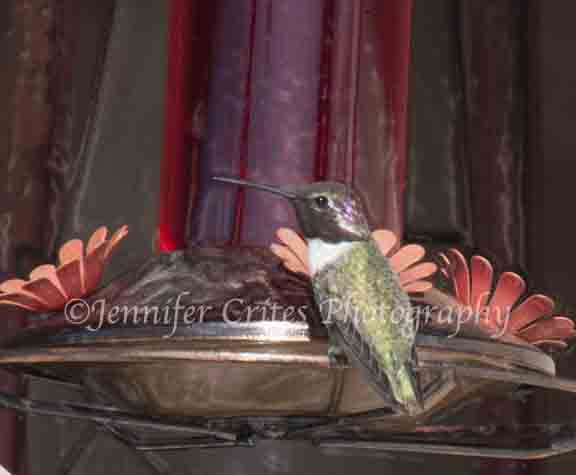
Hummingbirds can flash bright colors (I saw red, green and blue on the head), or hide them. The colors come from iridescence similar to that on a soap bubble or prism. Females find these iridescent feathers attractive.
A hummingbird’s brain is 4.2% of its body weight, the largest proportion in the bird kingdom.
Hummingbirds are very smart, and they can remember every flower they have been to and how long it will take a flower to refill.
A hummingbird does not drink through its beak like a straw. It uses its tongue, which is grooved in the shape of a W and has tiny hairs on its tip, to lap up nectar from flowers and feeders.
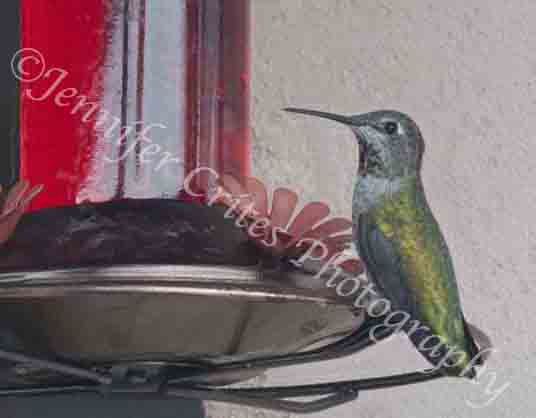
Hummingbirds spend most of their life perching. They have weak feet and can barely walk, preferring to fly. Their body temperature is around 107 degrees F.
An average sized hummingbird will have about 940 feathers.
30% of a hummingbird’s weight consists of flight muscles. In comparison, human pectoral muscles are about 6% of body weight.
Ruby-throated hummingbirds have been known to travel 500 miles across the Gulf of Mexico to breeding grounds. The trip takes an estimated 20 hours. Some hummingbirds will travel over 2,000 miles, twice a year, during migrations.
Contrary to popular misconception, hummingbirds do not migrate on the backs of geese. Geese fly on different migration paths or fly zones than hummingbirds.
Hummingbirds need to eat on average 7 times per hour for about 30-60 seconds (so I have to ask myself, how does a hummingbird make it 500 miles across the Gulf of Mexico?), and will visit an average of 1,000 flowers per day for nectar, lapping it up at a rate of about 13 licks per second. They also eat small soft bugs for protein.
To sleep, hummingbirds go into a hibernation-like state called torpor to conserve energy. When in torpor, they appear dead and have occasionally been found hanging upside down. It takes up to an hour to fully recover from torpor.
Hummingbirds are only found naturally in the Americas, as far north as Alaska and as far south as Chile.
There are more than 300 species of hummingbirds.
A hummingbird’s favorite color is red. They pollinate flowers by rubbing their forehead and face in the flower as they get nectar.
Early Spanish explorers called hummingbirds flying jewels. Can’t argue with that.
Fjords of Norway
Norway belongs to the sea. Along it’s western edge, the forces of water have carved a lacy filigree of bays, inlets and fjords like very few places on earth. It’s the fjords, of course, that capture the imagination. Ice Age glaciers creeping slowly across landmasses, carving out narrow channels that eventually fill with water as the glacier melts and retreats, and seawater encroaches. And they’re deep. Some, such as Sognefjord, plunge more than 4,000 feet below sea level, as deep as the height of mountains bordering them.

It looks like you could walk off the end of this viewing platform above the fjord. The glass front offers a majestic and spine-tingling view of the fjord below.
Where fjords meet the sea, glacially formed underwater valleys mix with other cross valleys to form a complex array of channels. These run parallel to the coast and are walled off from the sea by a chain of mountainous islands and rocks, making a protected passage along much of the entire 995-mile sea journey from Stavanger to North Cape, Norway.
During the winter, towns deep in fjord valleys can be cut off from the outside world. Snow buildups not only clog roads but can unleash avalanches of snow and rock that plunge into the water, sometimes resulting in fjord tidal waves over 100 feet high.

Our cruise ship anchored off the small town of Geiranger (pop. 250), Norway, at the terminus of the Geirangerfjord. During the 4-month summer tourist season, 140-180 cruise ships carrying several hundred-thousand people come here to experience the spectacular scenery. Nine-mile-long Geirangerfjord is a UNESCO World Heritage Site.
But in summer, cruise-ship passengers like us find fjords welcoming and awe inspiring, like peaceful blue-green lakes surrounded by snow-capped mountains and replete with ethereal waterfalls and picturesque towns.
Weekly Photo Challenge: Merge
This image depicts the merging of old and new, past and present, and the rise of plastic urbanization in the form of cars, roads and buildings. In the words of singer/songwriter Joni Mitchell, “they paved Paradise, put up a parking lot.”
Weekly Photo Challenge: Wrong
I was at least twenty feet away from a fluffy seagull chick, but this mother seagull obviously thought I was in the wrong place at the wrong time. If looks could kill. She dive-bombed me multiple times before finally realizing that I wasn’t posing a threat.
I would have liked to ask her why she chose this spot for a baby outing. The chick was on a small church lawn in the middle of a busy Norwegian town.








































































